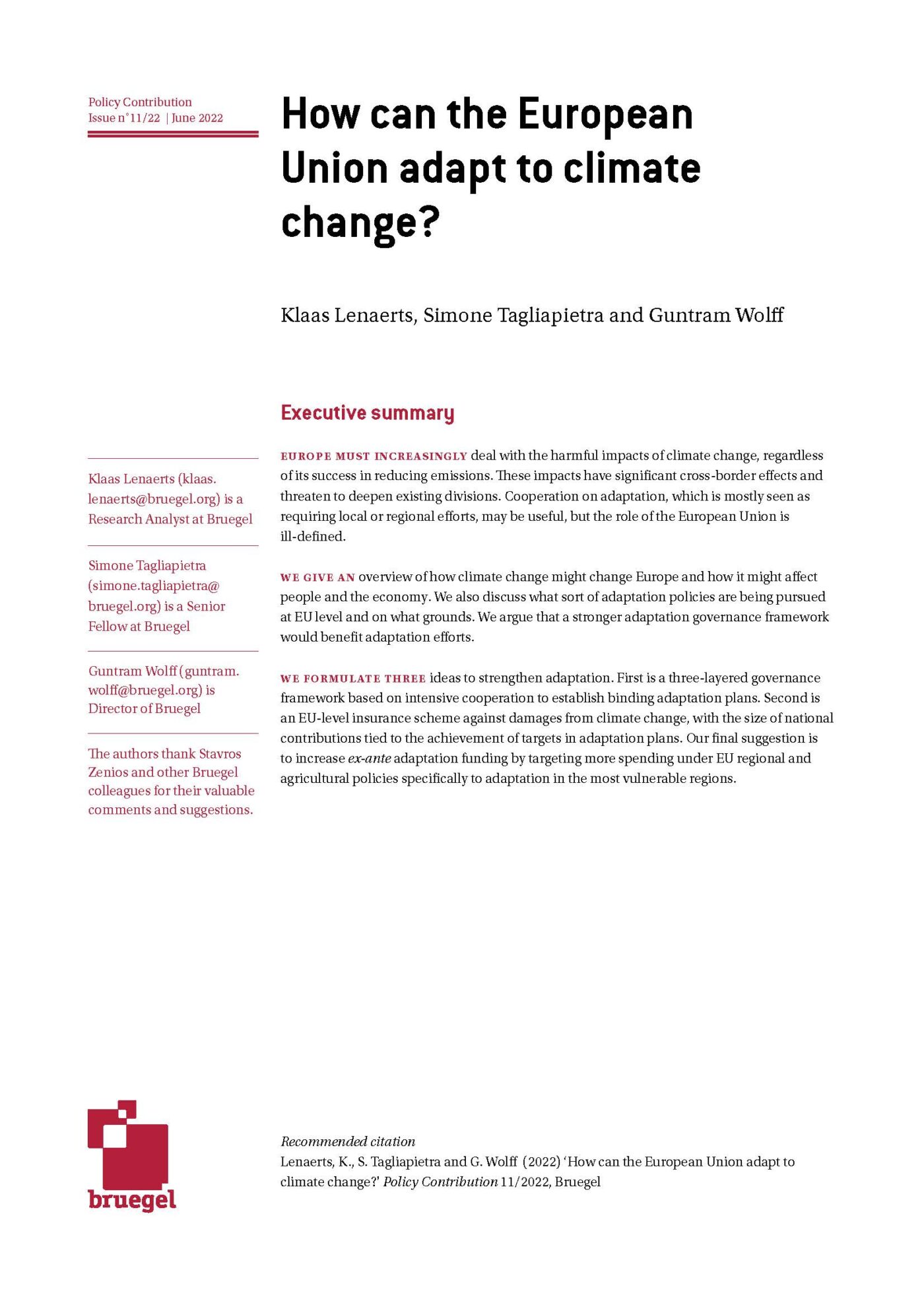Blog Post
Bold European Union action is needed to support Ukrainian refugees
Hosting Ukrainian refugees could cost European Union countries in excess of €40 billion this year. A dedicated EU fund is needed to manage the fiscal burden.
Russia’s invasion of Ukraine has created a humanitarian crisis. It has forced about 11 million people, in a country of 41.3 million in 2021, to leave their homes. By 1 April 2022, 6.5 million Ukrainians were internally displaced, while by 3 April, the number of people who had fled the country exceeded 4.2 million. These numbers continue to rise (Figure 1). The UN Refugee Agency also estimates that 13 million people are stranded in conflict areas.
The great majority (90%) of Ukrainian refugees have fled to the European Union. In response, the EU has welcomed them at speed and with unprecedented support. Below, the fiscal cost of this arrival is compared with the 2015-2016 refugee influx: for 2022, it could exceed €40 billion and will fall heavily on the four EU countries neighbouring Ukraine.
The Ukrainian refugee surge in light of the 2015-2016 refugee inflow
The countries receiving the largest numbers of Ukrainian refugees (as of 3 April, UNHCR data) are Poland (2.5 million – or 6.5% of the Polish population), Romania (643,000 – 3.4%), Moldova (395,000 – 15.3%), Hungary (390,000 – 4%), Russia (351,000 – including some that might have been forcibly relocated – 0.2%) and Slovakia (301,000 – 5.5%). These numbers refer to border crossings out of Ukraine, but many refugees have made onward journeys. Three-quarters of Ukrainian refugees who entered Moldova have already left (data probably collected from border checks when entering the EU). Within the European Union, Ukrainians can move freely due to the activation of the Temporary Protection Directive (see below) and thus the number who went from an initial recipient EU country to another EU country is not known. Accurate data on the final destinations of refugees will be available when residency permits are issued, which will take time.
Detailed data about who the Ukrainian refugees are is available for Moldova: the share of children is 36%, about half girls and half boys. About 80% of adult refugees are women, since 18-60-year-old Ukrainian males (without health problems) cannot leave the country.
Europe has not seen such an extensive humanitarian crisis since the Second World War. At the height of the 2015-2016 refugee crisis, the largest number of monthly new asylum applications was 161,000 (Figure 2). This time, there were days when more than 200,000 refugees arrived from Ukraine (Figure 1).
Activation of the Temporary Protection Directive greatly helps Ukrainian refugees
In 2015-2016, Europe experienced considerable difficulties in receiving far fewer refugees than now. Then, most asylum seekers were placed in refugee camps until their asylum applications were approved, which sometimes took a year. Even at the end of 2021, 760,000 people were still waiting for approval of their applications for asylum in the EU.
The unjustified military aggression against Ukraine, which has an association agreement with the EU, prompted for the first time the activation of the 2001 EU Temporary Protection Directive on 4 March 2022. Quick agreement seems remarkable in light of major disagreements between EU countries on migration and asylum policies. The compromise was that the protection under the directive applies only to Ukrainian citizens and people with refugee status in Ukraine and their families, while EU countries can decide how to deal with other citizens fleeing the conflict.
Temporary protection, which is initially granted for one year, allows displaced persons to reside in the EU and to access accommodation, social welfare, medical care and education in case of minors. It also gives the right to work, only subject to regular labour regulations. The European Commission issued guidelines on the implementation of temporary protection.
How could Ukrainian refugee inflows impact EU countries?
The challenge of supporting over 4 million refugees who arrived in just one month is enormous. The number of refugees is likely to increase further. Since the 1960s, there have been conflicts that caused much larger shares of populations to flee, suggesting that the number of Ukrainian refugees might increase significantly, if peace, security and prosperity are not restored.
Information suggested that in the first waves of arrivals in Poland, most Ukrainians – up to 80%-90% – were relatively well-resourced, with many meeting friends and relatives at the crossing and travelling on to Polish or other European cities. But after the first few days, the bulk of new refugees have limited resources and have no contacts in the EU. Many refugees need at least temporary accommodation from the day of arrival, immediate access to healthcare, and protection from violence and abuse, especially since most are young women and children. Finding permanent accommodation and schooling for children is also urgent. This is a vast challenge, especially for countries neighbouring Ukraine, and requires resources.
The potential to draw parallels with earlier crises is limited. For example, the main differences compared to the 2015-2016 refugee crisis are:
- This time, 80% of adult refugees are women (based on the statistics available for Moldova), while 74% were men in 2015-2016 (Figure 2). The share of children is also larger now (36%) than in 2015-2016 (31%).
- There is a large Ukrainian diaspora in the EU, which might help in finding accommodation for a sizeable share of refugees; in 2015-2016 such help was less available.
- Separated Ukrainian families will need reunification after the war. This might happen in Ukraine, implying the return of a significant share of the refugees. In 2015-2016, there were fewer children and most of the adults were young men, implying fewer family reunifications and lower incentives to return. The geographical closeness of Ukraine might also facilitate returns after the war, while Syria and other conflict-hit countries in 2015-2016 are further away.
- This time, temporary protection allows Ukrainian refugees to work, while in 2015-2016 asylum seekers could not work until their applications were approved. Still, finding work for Ukrainian refugees could be challenging because of language barriers, difficulties in recognising qualifications and job availability.
Fiscal costs
Due to the differences with past refugee crises, only a rough estimate of the fiscal costs of hosting Ukrainian refugees can be made based on past research. Clearly, short-term costs, when refugees need support but do not contribute much to tax revenues, will differ from long-term net costs, which take into account refugees who integrate into the labour market and need less support and pay more taxes.
A detailed breakdown of the various public costs and revenues related to refugees in Sweden in 2007 was made by Joakim Ruist. Converting Swedish krona values for total public costs to euros, then increasing the euro value in line with total euro-area inflation from 2007 to 2022, and finally dividing the amount by the number of refugees, gives a cost of €24,200 per person per year. Ruist also estimated revenue of an average of €14,600 per refugee per year, from labour (€9,300), consumption (€4,700) and other taxes (€600). Recently arrived Ukrainian refugees are unlikely to pay significant labour and other taxes soon, but their consumption will generate some tax revenues.
Jean Pisani-Ferry noted that German budgetary expenditures on refugees reached €9 billion in 2016, for about 750,000 applicants, which implies a cost of €12,000 per person per year at 2016 prices, or €13,500 at 2022 prices.
The European Commission estimated that the cumulative net incremental impact of refugees over 2015 and 2016 was largest in Sweden (0.9% of GDP), Austria (0.6% of GDP), Germany (0.5% of GDP), Finland (0.3% of GDP), and in Belgium, the Netherlands and Greece (0.2% of GDP). These GDP shares translate to €20,700 (at 2022 prices) per refugee in Sweden, €16,400 in Austria, €15,900 in Germany, €15,100 in Finland, €15,200 in Belgium, €22,500 for the Netherlands and €9,400 in Greece (see annex for details). IMF estimates arrived at broadly similar values. These values might underestimate the per-person cost if some of the refugees who arrived in 2015-2016 left the EU or started work in the EU before the end of 2016.
An OECD brief suggested that the typical cost for processing and accommodating asylum seekers can range from €8,000 to €12,000 per application for the first year (at 2015 prices), though these numbers might not include other related costs, such training, labour market policies, integration policies, and crime and justice.
Thus, there is a wide range of estimates of the per-person-year public cost of refugees of between €9000 and €25,000 (at 2022 prices).
Another unknown factor is the number of Ukrainian refugees who need support in the EU. Some of the refugees, who are wealthy and have family in Europe, might not need much public assistance, while others who arrive without contacts and money do need help. Some refugees might only pass through the EU. For example, the Biden Administration will welcome in the United States 100,000 Ukrainians and others fleeing Russia’s aggression.
It is also uncertain how many refugees will return to Ukraine when the war ends or even before. Some reports suggest that 370,000 refugees have already returned from Poland to Ukraine.
Any estimate of the fiscal cost of hosting Ukrainian refugees in the EU is thus bound to be uncertain. In a scenario in which the number of total refugees increases by 50% to 6.3 million, of which 90%, 5.7 million, enter the EU, of which only two-thirds require support from the EU, with an average cost of €15,000 per year, and for an average period of nine months in 2022, the total cost would amount to €43 billion this year.
This cost will fall disproportionally on the four EU countries neighbouring Ukraine. With the additional assumption that one-quarter of refugees who arrive in one of these four countries leaves to another EU countries, the cost in 2022 could amount to €21 billion (3.3% of GDP) for Poland, €5.4 billion (2.1%) for Romania, €3.3 billion (2.0%) for Hungary and €2.5 billion (2.4%) for Slovakia. These are rough estimates based on the assumptions listed and are subject to major uncertainty. Yet even if intra-EU movements and relocations of refugees larger than the assumed 25% reduce the burden on these four frontline EU countries, and rather significant private donations and support from various non-governmental organisations share the costs, the burden on public budgets will likely remain very substantial.
Another aspect is the medium- or longer-term fiscal impacts of refugees. As refugees start working, they require less public support and pay tax into public budgets. The literature typically concludes that over a decade or so, the net fiscal impact of refugees is close to zero or even positive, depending on the characteristics of refugee populations, skill complementarities and the efficiency of national institutions in terms of integration. Targeted labour market policies, language training, effective education and skill validation processes make integration more effective. No estimates for medium- and longer-term net costs are included here because of the uncertainty surrounding the number and timing of the return of refugees to Ukraine. Also, the share of children among Ukrainian refugees is larger than in past immigration.
European support
On 8 March, the European Commission proposed the Cohesion Action for Refugees in Europe (CARE) plan, which includes the release to countries hosting Ukrainian refugees of €420 million from unspent 2014-2020 migration and internal security funds, further amounts from unspent cohesion policy funds and the redirection of €10 billion from REACT-EU (which is a component of Next Generation EU). The European Parliament endorsed the plan on 24 March. These measures share the fiscal costs with the most impacted EU countries, though only partially. Redirection of REACT-EU funds implies those funds will not be used for their original purpose.
The principles of sincere cooperation (Article 4.3 of the Treaty on European Union) and solidarity (Article 80 of the Treaty on the Functioning of the European Union) provide a basis for EU countries to assist each other in the area of asylum and immigration. A delicate issue is that some countries now receiving many Ukrainian refugees previously resisted pan-European solidarity mechanisms after the 2015-2016 refugee crisis. Nevertheless, other EU countries should not point backwards but should act according to EU principles. The very unevenly distributed costs of hosting Ukrainian refugees calls for at least part of the costs to be shared.
One option would be the reallocation of funds from the 2022 annual EU budget. However, total planned spending this year amounts to €171 billion and commitments have already been made for a large share of this amount. Redirecting the rest to cover a significant portion of the approximately €40 billion in costs associated with refugees would likely be politically impossible. It might be easier to create a new fund to support Ukrainian refugees. Whether such a fund would be financed by national contributions or by EU borrowing is a secondary issue.
Recommended citation:
Darvas, Z. (2022) ‘Bold European Union action is needed to support Ukrainian refugees’, Bruegel Blog, 6 April
Annex: Translating percentage of GDP cost estimates into per person cost estimates
Numbers expressed as a percentage of GDP can be easily translated into euros. The challenge for cost per person per year calculations is using the correct number of refugees – for example in 2016, refugees who arrived that year and previous years needed support. Some who arrived in 2015 or 2016 might have left the EU by the end 2016 or have started work, reducing the need for support. For simplicity, this blog uses the cumulative number of new refugee arrivals from January 2015 to December 2016 and the annual average of this cumulative number as a reference for transferring total costs to per-person-year costs.
Republishing and referencing
Bruegel considers itself a public good and takes no institutional standpoint. Anyone is free to republish and/or quote this post without prior consent. Please provide a full reference, clearly stating Bruegel and the relevant author as the source, and include a prominent hyperlink to the original post.
















